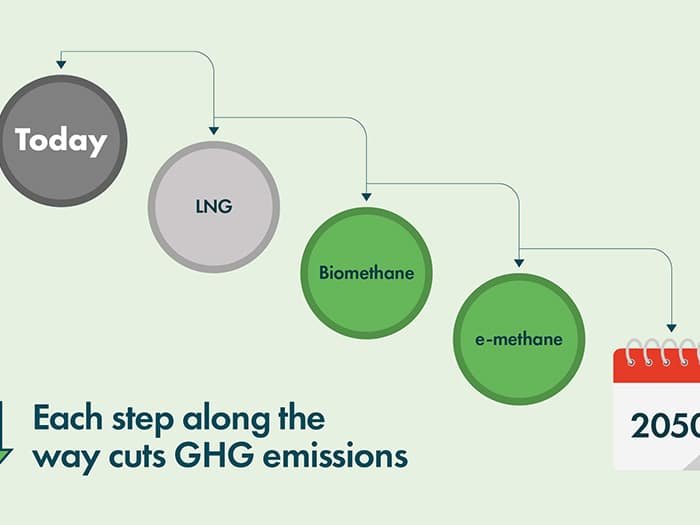In 2025, the urgent reality of regulations will set in for the shipping industry.
With the arrival of the new year, we begin the five-year countdown to IMO’s first notable deadline – reducing greenhouse gas emissions by a minimum of 20% by 2030.
Moreover, the EU’s Emissions Trading System (EU ETS) will likely see price increases over the coming 12 months, and beyond. The Carbon Intensity Indicator (CII) rating has become more stringent in a bid to cut carbon intensity in ships by at least 40% by 2030. And the long-awaited FuelEU Maritime will come into effect as of January 1, 2025.
All being said, local, regional and international regulations will begin to bite, and owners and operators are under growing pressure—and scrutiny.
One thing has never been so clear: achieving global goals requires realistic pathways which generate immediate and long-term results.
The Rising Demand of Shipping LNG Pathway
LNG in its current form has the ability to reduce GHG by up to 23% when used in a 2-stroke engine. To state the obvious, this figure immediately achieves the IMO’s reduction target of at least 20%, doing so five years ahead of deadline.
But a significant draw of the fuel is its ability to steer shipping’s decarbonization journey, remaining compliant, effective, and viable from now until net zero. Known as the LNG pathway, LNG, biomethane and e-methane provide a scalable method to achieving regulatory targets.
With liquefied biomethane, shipping can reduce GHG emissions by up 80% (or more when produced from the anaerobic digestion of waste materials), and with e-methane, shipping can achieve full decarbonization.
The vast potential for the fuel in transition is reflected in its rising demand and accessibility. At time of writing, LNG bunkers are available in ~185 ports worldwide, and by next year, this number is due to increase by another 50 ports. Comparatively, the liquefied biomethane market grew by around 20% in 2024, and the fuel is available in some 70 ports across Asia, North America and Europe.
Some of the most notable names in energy and maritime are also investing in the future fuels. Energy giant, Shell, revealed plans to develop two new biomethane plants in Germany in early 2024. While Titan has demonstrated its ongoing investment in the fuel, announcing they will be bunkering biomethane to all of UECC’s LNG dual-fuel car carriers.
E-methane, the next evolution in the LNG pathway, is also on the horizon. In 2024, Nordic energy company, Gasum, announced they’ll be distributing e-methane to both shipping and road companies as early as 2026.
The Pathway’s Commercial Edge
With increasing regulatory pressure and competitive global markets, maintaining commercial goals is an essential part of the future fuels equation.
Biomethane and e-methane have significant cost advantages over alternatives as they’re compatible with existing bunkering infrastructure and proven, safe shipboard technologies. Meaning far less CAPEX than other alternatives.
Biomethane is the lowest cost green fuel for shipping, due to the high cost of renewable green hydrogen—the common feedstock which makes up 70-80% of the costs for all e-fuels, including e-methanol and e-ammonia.
Existing infrastructure for both methanol and ammonia is also significantly limited. Much of the fuels are produced locally, making it challenging to generate the volumes required for scalable adoption.
Eliminating Methane Slip
Tackling methane slip, arguably the most-cited challenge to widespread LNG uptake, is already well underway.
High pressure dual-fuel engine technologies already exist with virtually no methane slip. In low pressure engines where it remains an issue, continuing innovations by engine manufacturers have resulted in levels of methane slip falling more than four-fold over the past 25 years.
ROTOBOOST, a global hydrogen technology company, has developed a pre-combustion carbon removal system, cracking the methane molecule into hydrogen and solid carbon. The hydrogen is mixed into the methane fuel feed flow to the engines, directly contributing to lower methane and carbon dioxide emissions. The solid carbon is captured on board and off-loaded at the next port call to find its way into industrial products.
The Methane Abatement in Maritime Innovation Initiative has been piloting abatement technologies, as well as developing a methane measurement, certification and validation protocol for regulators to help shipping quantify and eliminate slip.
Viable. Commercial. Scalable.
Waiting is not an option. It’s a sentiment we’ve known and vocalized for some years. But now, as we mark the start of 2025, it’s truer than ever.
From now, to 2030, to 2050’s net zero vision, the LNG pathway provides a viable, commercial and sustainable route to achieve global regulations and emission reduction targets. The fuels can effectively cut GHG and help achieve full decarbonization using existing infrastructure and technology.
While there’s no silver bullet, the continued innovation, investment and potential of the LNG pathway makes it the most realistic option to achieving compliance in today’s competitive landscape.

